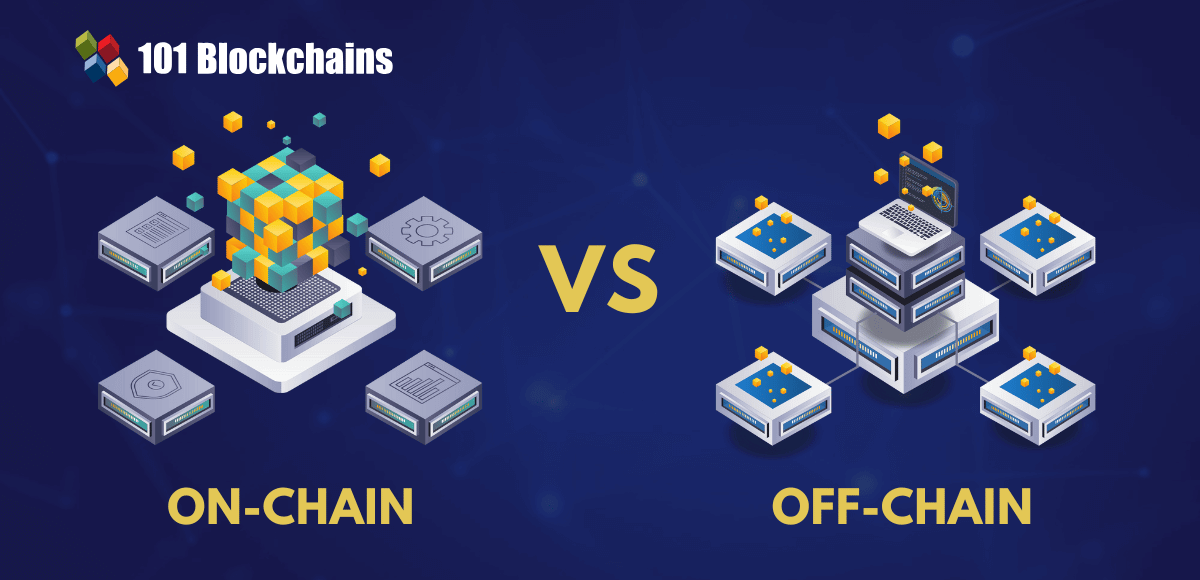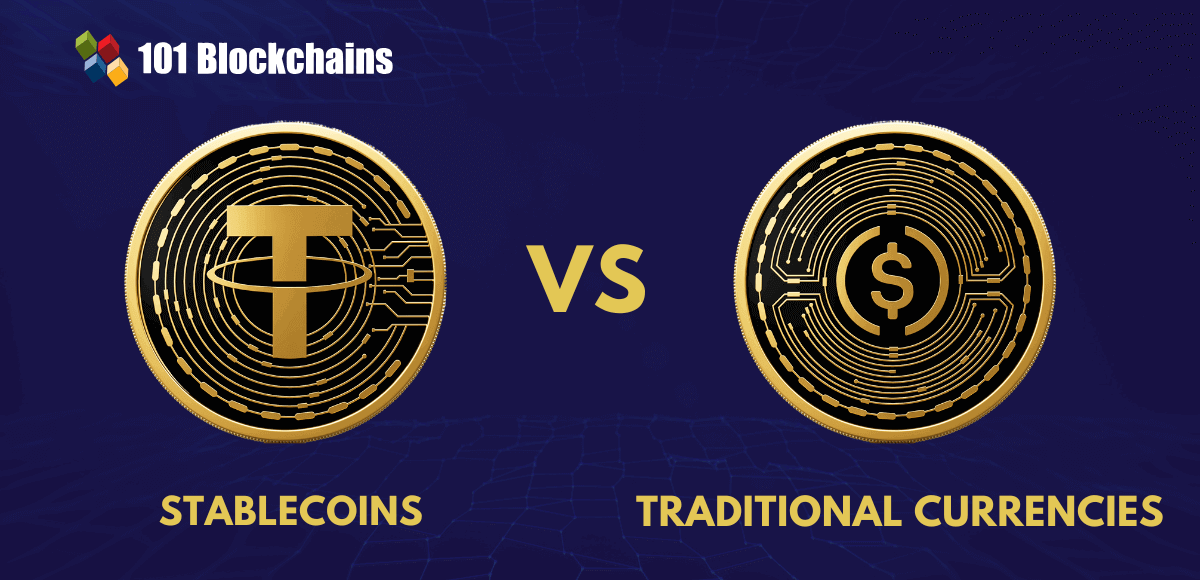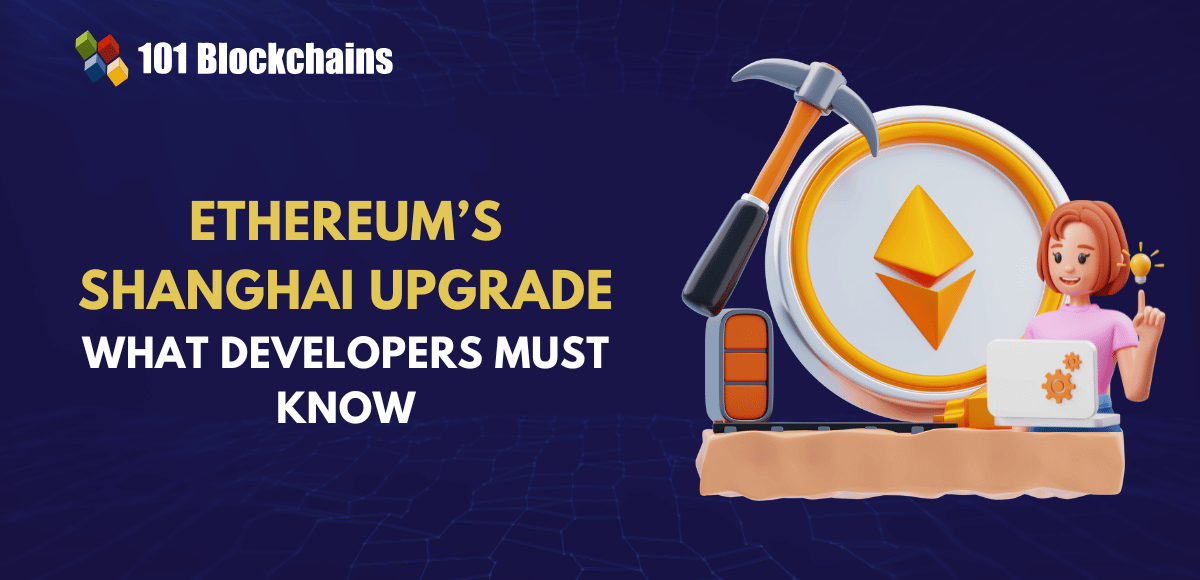Learn how blockchain truly works, master key definitions, and uncover what makes smart contracts so "smart." Dive into the fundamentals, gain valuable insights, and start your blockchain journey today!
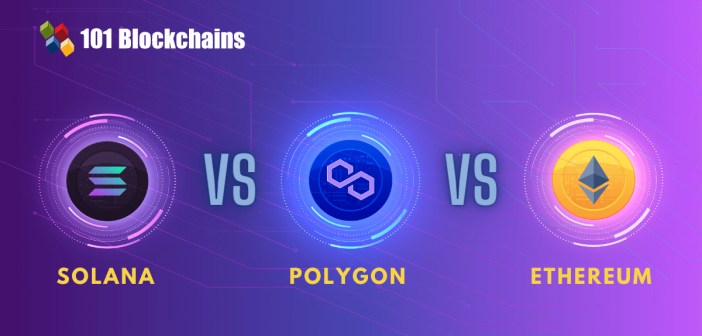
- Comparisons
Georgia Weston
- on February 11, 2022
Solana vs Polygon vs Ethereum – A Detailed Comparison
Want to know which blockchain platform will be the best option for the development purpose? This detailed comparison of Solana vs Polygon vs Ethereum will help you make the right choice.
A few years ago, no one would have imagined how blockchain and cryptocurrency would change the world. Today, we witness new business models emerging on the foundations of blockchain technology. Prominent trends such as NFTs and decentralized finance have become the most talked-about terms in recent times. As the demand for such blockchain-based solutions continues increasing, the need for blockchain platforms to develop such solutions has also grown considerably.
The Solana vs Polygon vs Ethereum comparison draws its footnotes directly from such concerns. Which of these three blockchain platforms is an ideal pick from the development perspective? While Ethereum successfully achieved a value of $4818.97 at the beginning of November 2021, it has been dwindling down when placed against its competitors. Is the falling exchange value an indicator of the blockchain network’s performance?
The following discussion would help you find out the difference between Solana, Polygon, and Ethereum on the basis of different factors. You can identify the suitable best pick from the three competitors according to their capabilities in different areas.
Excited to build your skill in Ethereum development by leveraging the ethers.js library? Enroll Now in the Ethers.Js Blockchain Developer Course!
Why Should You Focus on Solana vs Polygon vs Ethereum Comparison?
One of the first things you need to keep in mind while comparing Solana or any other blockchain network with others is that you cannot rely on the exchange value alone. For example, the fluctuating prices of Ethereum can be an alarming issue for investors. However, does it mean that rival blockchain networks such as Polygon are better? No.
Ethereum is undoubtedly the basis for developing smart contracts, NFTs, and Decentralized Finance or DeFi applications. The platform serves as a popular choice for all these functionalities. However, it also faces many challenges in fighting off its competition. The growing momentum in the NFT space and DeFi ecosystem has led to massive growth in competition among layer-one protocols. Even if many NFT marketplace developers look up to ETH, other layer one protocols entered the scene in 2022.
The new players like Solana introduced the advantages of reduced costs and better transaction speed. On the other hand, ETH offers better features with the ETH 2.0 improvement, possibly for outsmarting competitors like Polygon. At the same time, ETH has the most diverse and transparent landscape of decentralized applications.
Therefore, it is important to reflect on the difference between Solana, Polygon, and Ethereum in detail before making conclusive statements. Let us begin with a brief overview of each blockchain platform before diving into the differences between them.
-
Ethereum
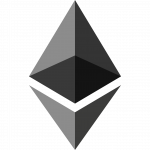
Ethereum is presently the second most popular blockchain platform after Bitcoin. It not only provides the foundation for cryptocurrencies but also the essential resources for developing decentralized applications. The blockchain platform has successfully created a profitable and open economy.
With its data-effective services and multiple applications, Ethereum also empowers accessibility for everyone irrespective of background and location. It is also important to note that all programs linked to Ethereum require intensive computing power. The platform has been an active influencer driving the growth in demand for digital collectibles. As a result, it obviously enjoys being the first choice for service providers offering development of the NFT marketplace.
Want to develop expertise in Ethereum? Enroll Now in Ethereum Technology Course
-
Solana
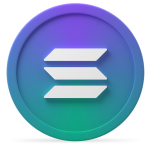
The next prominent entry in the Solana vs Polygon vs Ethereum comparison draws our attention toward another decentralized blockchain network. Solana blockchain has been tailored for developing highly scalable and user-oriented applications. The blockchain network is practically the fastest one right now and offers one of the fastest and most efficient ecosystems. It now features over 400 DeFi, NFT, and web3 solutions. Blockchain developers can make the most of the efficiency and transaction speed associated with the Solana network.
You can carry out almost 3000 transactions each second on the platform while it features the ability to handle between 50,000 and 65,000 transactions every second. Therefore, Solana is definitely a strong competitor to the other popular blockchain platforms.
Enroll now in the Solana Development Course to understand the workings of the Anchor framework, Solana Program Library, and Solana tokens.
-
Polygon

Polygon is also another top entry among renowned blockchain platforms for developing new digital assets and economies. Also referred to as the Matic network, it is the Internet of Blockchain for Ethereum. It seems quite confusing, isn’t it? Well, if you look closely, you will find that it focuses on enabling the multichain ETH ecosystem.
The most interesting highlight of Polygon is that the network offers interoperability with all the present and future infrastructure scenarios for ETH. In addition, Polygon has been tailored to offer interoperability with the new layer 2 solutions. Most important of all, the Matic network has the promising advantage of being the fastest in transaction speed.
Excited to develop a comprehensive understanding of Polygon? Enroll in Polygon Fundamentals Course!
Differences between Solana, Polygon, and Ethereum
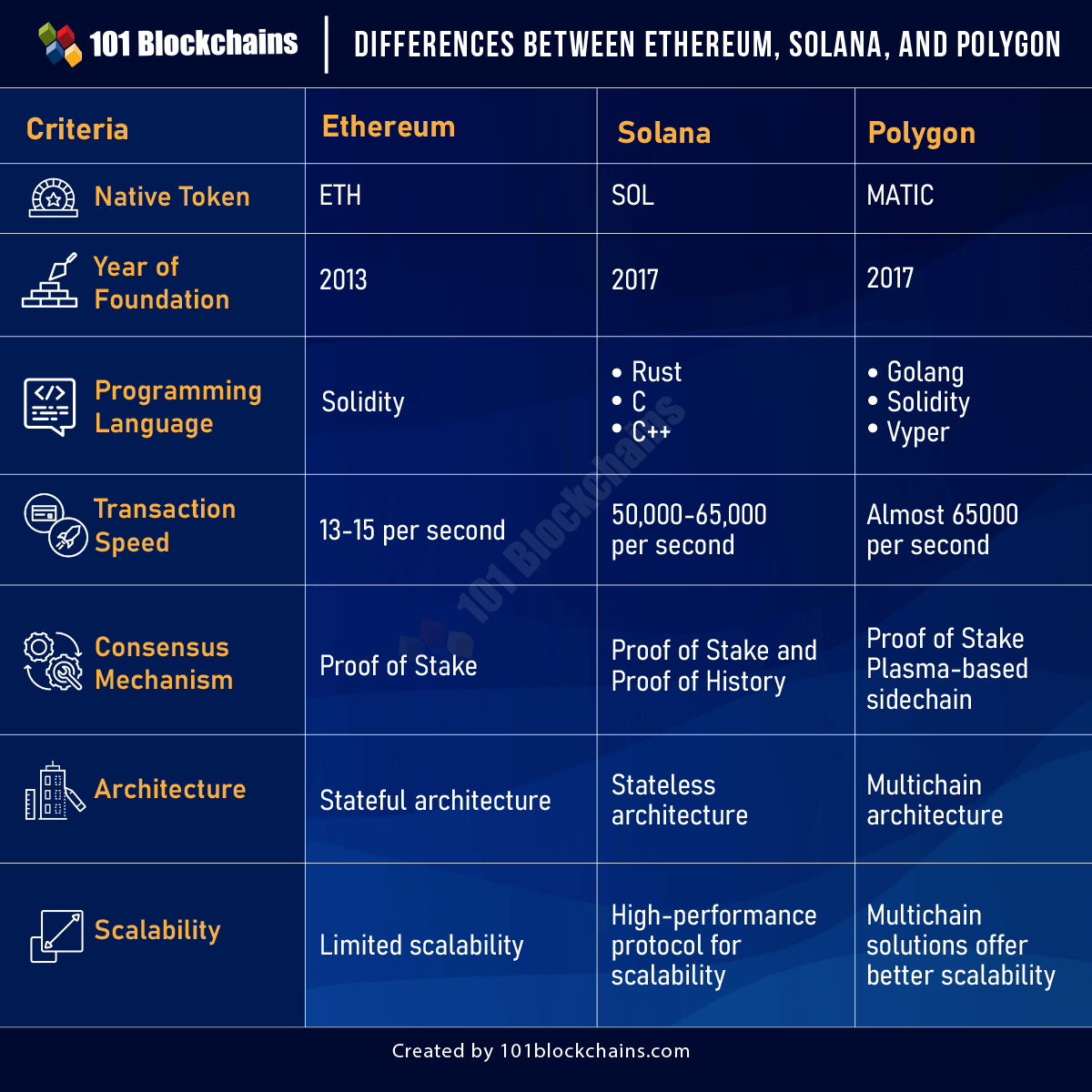
Please include attribution to 101blockchains.com with this graphic. <a href='https://101blockchains.com/blockchain-infographics/'> <img src='https://101blockchains.com/wp-content/uploads/2022/02/Differences-between-Ethereum-Solana-and-Polygon-1.png' alt='Differences between Ethereum, Solana, and Polygon='0' /> </a>
With a basic overview of all players in the Solana vs Polygon vs Ethereum comparison, it is reasonable to turn toward the differences between them. Let us take note of the difference between Solana, Polygon, and Ethereum on the basis of the following factors.
-
Consensus Mechanism
Consensus mechanism is a mandatory procedure followed by all blockchain nodes to reach agreements regarding the present state of the network. Ethereum presently leverages the Proof of Stake or PoS consensus mechanism, drawing power from multiple miners worldwide participating actively in the consensus. Proof of Work consensus demands high computing power, thereby restricting the scope of participation for users. Even if Proof of Work helps to ensure security and complete decentralization for ETH, it suffers from concerns of reduced performance.
Polygon leverages a combination of technologies to offer a fast blockchain network alongside linking to the main ETH network. The blockchain network leverages the Proof of Stake consensus mechanism for securing the network and creating new MATIC tokens. Therefore, you can also earn rewards in the form of MATIC tokens by staking on the Polygon network.
Solana blockchain brings something unique to the table in terms of its consensus mechanism. The network utilizes an array or list of computations to determine the ideal method for verification of the time gap between two different events. Interestingly, the Solana blockchain leverages one cryptographically secure function to facilitate output prediction.
Rather than relying on the PoW consensus, the blockchain platform uses a hybrid consensus mechanism that features the best Proof of Stake as well as Proof of History. The hybrid consensus on the Solana blockchain enables better flexibility for arranging the order of transactions. As a result, the consensus mechanism of the blockchain platform empowers it to carry out almost 50,000 transactions every second.
Curious to learn about blockchain implementation and strategy for managing your blockchain projects? Enroll Now in Blockchain Technology – Implementation And Strategy Course!
-
Faster Transactions
Speaking of transaction speed, it is also one of the prime factors for identifying the best pick from a Solana vs Polygon vs Ethereum comparison. The speed of blockchain platforms is important when comparing them to find which one will be a better fit. In the case of Ethereum, every participant holds a copy of the digital ledger.
The distributed ledger holders take care of the operation and management of the network. Therefore, ETH is capable of processing a limited number of transactions every second. In addition, Ethereum is highly crowded, and you might have to wait to verify your transaction or pay a huge fee for the same.
The difference between Solana, Polygon, and Ethereum in terms of transaction speed turns in favor of competitors to ETH. For example, Solana depends on the Tower Byzantine Fault Tolerance of tBFT, an improved variant of pBFT or Practical Byzantine Fault Tolerance. The blockchain network takes away the need for any real-time communication among nodes, thereby improving overall efficiency. Furthermore, Solana also leverages Gulfstream to push transactions to the edge. Since network validators can easily conduct transactions at better speeds, the network can easily process over 50000 transactions every second.
The final competitor, i.e., Polygon, does not have any competition from the other two when it comes to transaction speed. With the capability to process around 65,000 transactions every second, the network is a clear winner for developers and users.
-
Stateful Architecture
Another important criterion for Solana vs Polygon vs Ethereum comparison draws stateful architecture into the equation. Certain blockchain networks maintain a state while others do not have the design for the same. A particular contract can be considered stateless only when it avoids any changes in its state. In other words, the contract does not modify the storage variable values.
Ethereum provides a true example of stateful architecture by recording all transactions in the existing state. In the event of the latest transaction, the complete network should update the copies of the transaction to mirror the recent transaction. As a result, the network is slower in comparison to stateless blockchain networks.
Polygon gives one of the most significant tools for participating in and driving a new borderless society and economy. You should note that the sidechain works like other POS blockchains. In addition, the exchanges are present in the form of a cluster on the ETH mainnet.
The architecture of the Solana blockchain relies a lot on the Solana cluster. The cluster is basically a collection of validators working together to address client transactions alongside ledger maintenance. Every cluster has its own leader, and the role continues rotating among the validators. The cluster leader takes on the responsibility of bundling and timestamping the incoming transactions by using Proof of History consensus. With a stateless architecture, there is no need to update the whole state of the Solana blockchain with every new transaction. Most important of all, you can notice how a stateless architecture provides the assurance for better scalability of the blockchain platform.
-
Scalability
The most critical factor of difference between Solana, Polygon, and Ethereum would obviously refer to scalability. Blockchain networks should be adequately scalable to ensure the completion of the desired transactions.
In the case of Ethereum, the transaction speed is 15 transactions each second, thereby making it a bit slower than other competitors. However, the development of layer 2 scaling solutions and support for multichain networks can help in resolving the concerns of scalability.
Solana can address the problem of scalability with a high-performance protocol that offers innovative time architecture, improved transaction processing speeds, and an efficient consensus model.
The third player in the Solana vs Polygon vs Ethereum debate works on offering scalability through plasma-enabled sidechain and multichain functionality.
Start your blockchain journey Now with the Blockchains Fundamentals Course
Final Words
The emerging use cases of blockchain are gaining everyone’s attention, starting from investors and enterprises to the general public. Almost any individual who is aware of the crypto space wants to capitalize on the opportunities in the space. Most important of all, it is quite impossible to ignore the crypto space, which is bustling up right now with multiple new opportunities.
For example, Decentralized Finance or DeFi and NFTs are the two biggest trends in the crypto space right now. Therefore, the comparison of Solana vs Polygon vs Ethereum is essential for figuring out the ideal option moving forward. Even if the new competitors are offering a lot of competition, ETH has a strong command over the crypto, DeFi, and NFT space. What happens in the long term will be all but a matter of speculation. Learn more about blockchain networks right now.
*Disclaimer: The article should not be taken as, and is not intended to provide any investment advice. Claims made in this article do not constitute investment advice and should not be taken as such. 101 Blockchains shall not be responsible for any loss sustained by any person who relies on this article. Do your own research!



